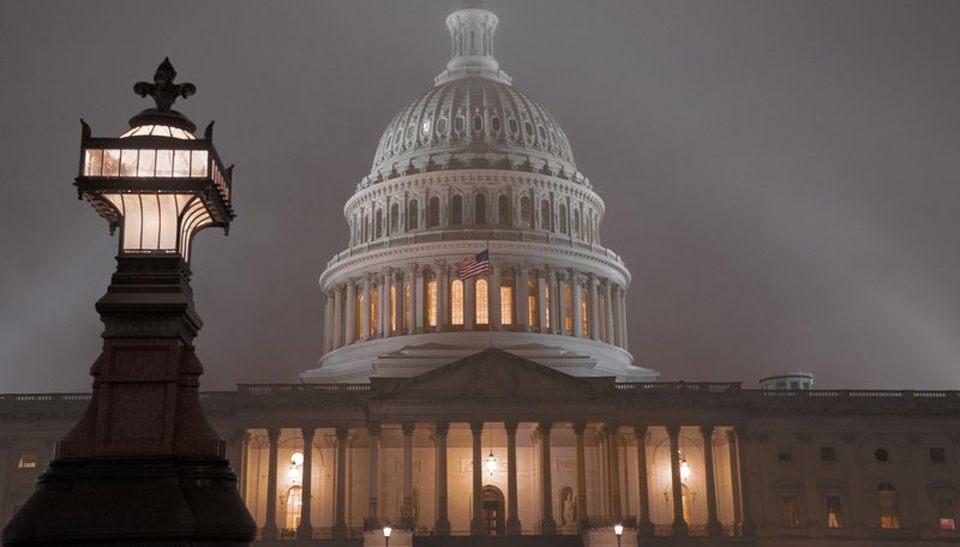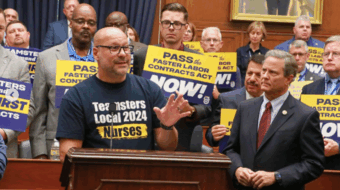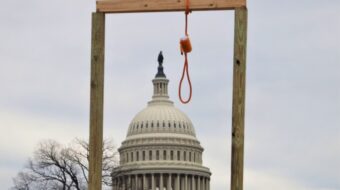
WASHINGTON (PAI)— On the eve of impeachment, the House rushed through two “minibus” spending bills that give Trump some money for his border wall, though not as much as he had demanded, and score some wins for particular segments of the workforce.
Those were the key takeaways as Congress enacted one bill covering national security and the other covering domestic programs to fund the government through next fall. The measures total $1.4 trillion. The money funds operations through the fiscal year that ends Sept. 30. The Mine Workers union and the nation’s past and present coal miners won gains that go in the direction of protecting their health care and pensions. Lawmakers also repealed the Affordable Care Act’s “Cadillac tax” on high-value health care plans, for good, too.
The money bills, impeachment of President Donald Trump, and of legislation implementing the U.S.-Mexico-Canada Agreement (USMCA)—successor to the disastrous 26-year-old NAFTA—were the three big-ticket items on the congressional agenda as lawmakers rushed for their holiday recess.
The Senate will consider the USMCA bill in January, after it gets done trying Trump on one count of high crimes and misdemeanors for bribery and abuse of power and another count for defying congressional investigations of his maledictions. The GOP-run Senate is expected to acquit him.
Workers racked up some other wins, too. Two million federal employees will get a 3.1% raise starting Jan. 1, and worker safety agencies got more money—not less, as Trump wanted.
But there was another big impact left unsaid: There won’t be another Trump government shutdown, unlike last December and January. Then, he locked out 400,000 federal workers for more than a month and forced another 400,000 to work without pay. This time, a grumbling Trump was expected to sign the two “minibus” money bills.
Money for the border wall
In one of the more controversial moves, lawmakers gave Trump money for his border wall, but they cut his $5 billion demand by 72%, to $1.375 billion. Lawmakers also established an Immigration Detention Ombudsman’s Office to handle and investigate Border Patrol and ICE agents’ mistreatment and violations of migrants’ rights.
Little work has been done on Trump’s Mexican Wall, which foes call both ineffective and racist. More than half of the 1,950-mile U.S.-Mexico border has some sort of fencing already, but Trump-hired contractors replaced only 83 miles of current fencing, and built no new walls.
Meanwhile, just days before the passage of the bill, U.S. District Judge David Briones in El Paso ruled on Dec. 11 that Trump’s last scheme to divert $3.6 billion from the Defense Department to build the wall was an unconstitutional usurpation of the congressional “power of the purse.” Briones issued a nationwide injunction against Trump’s diversion of money for building the wall.
“The court cannot blind itself to the plain reality presented in this case: The border barrier projects defendants”—Trump and his agencies—“now assert are ‘necessary to support the use of the armed forces’ are the very same projects defendants sought—and failed—to build under DHS’s civilian authority, because Congress would not appropriate the requested funds,” Briones wrote.
Foes of the wall, including humanitarian groups along the U.S.-Mexico border, and El Paso County, cheered Briones’s ruling. House Majority Leader Steny Hoyer, D-Md., had said after the ruling Democrats would keep fighting against the wall funding.
Fernando Garcia, Executive Director of the Border Network for Human Rights, a lead border wall foe in the suit against Trump’s military money diversion, called the decision “a major win for border communities and the families BNHR represents.”
“By issuing a border-wide injunction, the court reaffirms our argument that the use of military construction funds to build the wall was an unlawful act by President Trump. To the extent this president uses his powers unlawfully to build an expensive, unnecessary wall that negatively impacts our community, BNHR will fight him in the courts and in any other appropriate venue.”
Trump’s attempt to “steal” Pentagon money for the wall “is unconstitutional and illegal,” said Hoyer after Briones’s decision. Hoyer said the wall undermines national security, too.
The inclusion of funds for the wall—even an amount lower than Trump requested—upset many Democratic reps. The Hispanic Caucus and the Progressive Caucus, after conferring behind closed doors, announced their joint opposition to the bill.
Pension and health wins…of a sort
The biggest worker win was a pension solution for the miners, their retirees, and their surviving spouses and descendants. Bankruptcies of coal companies thanks to the Great Recession, declining coal production and numbers of active miners—which cut revenues coming into miners’ pension funds—and rising numbers of retirees had left the miners’ pension plans running out of cash.

“The end of our 10-year battle to preserve the pensions and health care our retirees earned in sweat and blood is in sight. Let’s get this done in Congress, and put it on President Trump’s desk for his signature,” Mine Workers President Cecil Roberts said after Congress approved the money bill, with $260 million in pension money in it.
In return, pension payments are frozen, and the pension plans have to meet tougher reporting and accounting standards to keep receiving the flow of funds. The two miners’ plans, which the federal government approved in 1947 and 1974, would have had to cut already small pension payouts—less than $600 monthly per recipient on average—starting in March. Health benefits would run out, too.
Until now, Congress had kicked the can down the road, with short-term fixes. But Sen. Joe Manchin, D-W. Va., leader of a bipartisan coalition of coal-state senators who had crafted a solution, threatened to stop everything—the money bills included—unless the miners’ problems were solved.
“This agreement was a sacred promise between worker and country, and it captured the very best of our American values,” Manchin told his colleagues in the final debate. “We kept that promise by including the Bipartisan American Miners Act in the end-of-year funding bill.”
Other union leaders hailed the permanent death of the so-called “Cadillac tax,” which Democratic President Barack Obama forced into the ACA, as a supposed cost-saving measure, a decade ago, over labor’s strong objections.
Unions swallowed hard and backed the ACA—and have spent the ensuing decade first getting lawmakers to postpone it, and now, to repeal it. They pointed out, rightly, the tax would hit users of the high-value plans—most of them bargained collectively— particularly hard.
AFL-CIO President Richard Trumka called Cadillac tax repeal “a major bipartisan victory.” Left unsaid: Right-wing-run business lobbies also pushed the repeal, not because they agree with workers, but because they, like Trump, hate taxes, the government, and the ACA.
“This ill-advised and misleadingly named tax was threatening the health care security of millions of working people—pushing employers to hollow out benefits while driving up deductibles and co-pays,” Trumka said in a statement.
“Since its inception, the building trades and their allies have worked to repeal this misguided policy that would undermine the healthcare coverage of millions of hard-working Americans and their families,” said Sean McGarvey, president of North America’s Building Trades Unions.
McGarvey also applauded the miners’ pensions solution, but said work in that area isn’t done. Congress, he noted, must still figure out what to do about other financially troubled multi-employer pension plans, whose distress could cut the pensions of Teamsters, longshore workers, and United Food and Commercial Workers members, among others.
Assorted other measures
Other worker wins include banning the U.S. Postal Service from implementing the GOP regime’s edict to eliminate Saturday postal deliveries, a 3.1% raise for all federal workers, and preservation of some protections for civilian Defense Department workers.
The Commerce Department section of the “minibus” includes $118 million for infrastructure projects in low-income communities, via the Economic Development Administration. Trump wanted to kill the entire $333 million for all of EDA.
The money bill’s transportation section also saves the Amtrak Southwest Chief long-distance train, restores Amtrak agents to rural stations, adds money for air traffic control improvements, and bans using federal funds for “misguided automation” of longshore workers’ jobs, said AFL-CIO Transportation Trades Department President Larry Willis.
The measure also overrides Trump’s ban on building a new rail tunnel under the Hudson River between Manhattan and New Jersey, thus ending a major freight bottleneck. Trump stopped the funds because—in so many words—New York and New Jersey are “blue states” that didn’t support him in 2016, though Willis was too polite to say so.
Trump also wanted to politicize the civil service, which he hates. The money bill turned his scheme down flat, by banning a merger he sought that would have eliminated the government’s personnel office and put personnel decisions under White House control. That turndown cheered the Government Employees (AFGE) and the Treasury Employees (NTEU).
That rejection won’t stop Trump’s war on workers. He derisively calls the two million federal workers “the deep state” and his executive orders strip workers and their unions of due process rights, protection against unjustified firings, and even of the small offices, phones, fax machines, and computers its unions use to handle grievances and protect them.
Workers overall won when lawmakers added $48 million to Trump’s requests for spending on worker protection programs—the Occupational Safety and Health Administration, the Mine Safety and Health Administration, and the Labor Department’s Wage and Hour Division, which enforces overtime pay and minimum wage laws.
Half of the overall hike goes to OSHA, increasing its budget to $582 million. But OSHA still has fewer inspectors now than when it began in 1970.
DOL’s program to help women learn building trades will get $1.3 million, $300,000 more than this year. Trump wanted zero. And “for the first time in more than 20 years, the bill includes funding, $12.5 million, to specifically support firearm injury and mortality prevention research,” at the Centers for Disease Control, the House Appropriations Committee said.
That’s a direct result of the long and strong, and politically successful, drive by the student-led March for Our Lives, aided by the nation’s two big teachers unions, to demand stronger gun control laws. That, and the Democratic House, triumphed over the GOP Senate majority and the infamous gun lobby, the National Rifle Association.

Maritime trades unions also won in the money bills. They allot $1 billion for the Maritime Administration, which works closely with the unions to ensure enough workers on the U.S. merchant fleet, in case of military need. That’s a $67 million cut from this past fiscal year, but Trump wanted to cut $390 million—and zero money to rebuild U.S. ports.
Fire Fighters won, too: There’s $710 million for the two federal fire grant programs—one for training and the other for equipment—is virtually the same amount as in fiscal 2019, which ended Sept. 30.
One final money bill irony: The House cut the government’s annual payment to Washington, D.C., by $11 million. But within the $714 million total, lawmakers budgeted $18 million—50% more than in fiscal 2019—for “D.C. emergency planning and security costs.”
The city has been forced to shell out additional millions of dollars ever since Trump took office to cover everything from police overtime to port-a-potties to cover costs of the always justified and virtually weekly demonstrations against the president and his policies.










